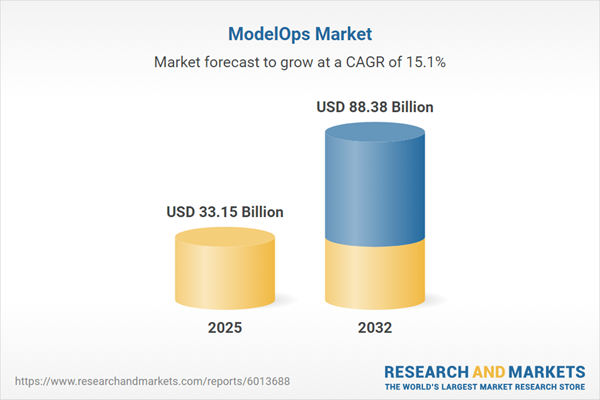Speak directly to the analyst to clarify any post sales queries you may have.
The ModelOps market is rapidly transforming how enterprises manage machine learning models, ensuring scalable, secure, and reliable AI deployment. Senior leaders recognize ModelOps as a foundational capability for leveraging analytics and achieving measurable business outcomes in dynamic operating environments.
Market Snapshot: Strong Growth Trajectory in the ModelOps Market
The ModelOps market grew from USD 28.76 billion in 2024 to USD 33.15 billion in 2025, and is forecast to continue expanding at a CAGR of 15.06%, reaching USD 88.38 billion by 2032. This growth demonstrates escalating enterprise demand for structured model lifecycle management, robust governance, and deployment efficiency as machine learning becomes a core driver of strategic advantage.
Scope & Segmentation of the ModelOps Market
- Components: Platform solutions enabling model deployment, governance, monitoring, drift detection, and performance management; professional services supporting consulting, integration, deployment, support, and maintenance.
- Deployment Modes: Cloud-based environments, hybrid architectures, and on-premises installations aligned to compliance or data sovereignty requirements.
- Organization Size: Solutions tailored for large enterprises requiring end-to-end integration; SMBs adopting modular, scalable options with reduced upfront cost.
- Industry Verticals: Banking and financial services, insurance, healthcare and life sciences, IT and telecom, retail and ecommerce—each vertical marked by distinctive operational needs and regulatory priorities.
- Geographic Regions: Americas (North America, Latin America), Europe, Middle East, Africa, and Asia-Pacific, with regional differences shaped by regulations, talent pools, and infrastructure investments.
- Representative Technologies: Cloud-native platforms, CI/CD pipelines for machine learning, low-code and no-code deployment tools, open-source frameworks, and leading-edge infrastructure providers.
- Key Market Players: Amazon Web Services, Microsoft Corporation, Google LLC, IBM, DataRobot, Databricks, SAS Institute, Domino Data Lab, Dataiku.
Key Takeaways for Senior Decision Makers
- ModelOps has moved from a specialized IT domain to a strategic function supporting real-time enterprise decision-making and differentiation.
- Cloud-native and hybrid architectures enable operational agility while addressing local data compliance mandates and cost control imperatives.
- Emerging regulatory expectations are driving greater adoption of transparent, auditable, and governance-focused ModelOps infrastructure across all major industries.
- Low-code and open-source solutions empower citizen data scientists and foster internal collaboration, accelerating experimentation and scaling models to production.
- B2B adoption patterns differ by segment: regulated industries emphasize risk mitigation and auditability, while verticals such as telecom and retail seek efficiency gains and customer personalization.
- Partnerships, acquisitions, and ecosystem alliances shape technological advancement, enabling organizations to extend ModelOps capabilities and embed compliance or analytics features.
Impact of 2025 US Trade Tariffs
Recent United States trade tariffs have introduced complexity for ModelOps buyers reliant on distributed hardware and imported components. Increased costs—especially for semiconductors—prompt enterprises to reconsider on-premises investments versus cloud deployments, drive up software licensing prices, and accelerate domestic infrastructure expansion. Strategic supplier partnerships and bundled, tariff-protected solutions are mitigating some risk, balancing operational resilience with cost containment.
Methodology & Data Sources
This research combines robust secondary analysis of white papers, technical documentation, and regulatory filings with targeted interviews of data science and IT leaders. Market segmentation and triangulation of quantitative data from vendor disclosures, user surveys, and financial reports ensure accuracy. Peer review by a board of industry experts strengthens methodological rigor and objectivity.
Why This Report Matters
- Delivers actionable market intelligence to support efficient ModelOps investments and risk management amid evolving technologies and regulations.
- Clarifies buyer priorities and adoption patterns by segment, informing product strategy and competitive positioning for enterprise leaders.
- Enables leadership to benchmark against industry best practices and rapidly adapt ModelOps approaches for sustained growth.
Conclusion
ModelOps is now essential for delivering scalable AI, guiding enterprise risk control, and driving operational efficiency. Organizations that align governance, deployment, and monitoring with evolving regulatory and infrastructure demands will sustain competitive advantage and unlock new business value.
Additional Product Information:
- Purchase of this report includes 1 year online access with quarterly updates.
- This report can be updated on request. Please contact our Customer Experience team using the Ask a Question widget on our website.
Table of Contents
3. Executive Summary
4. Market Overview
7. Cumulative Impact of Artificial Intelligence 2025
Companies Mentioned
The companies profiled in this ModelOps market report include:- Amazon Web Services, Inc.
- Microsoft Corporation
- Google LLC
- International Business Machines Corporation
- DataRobot, Inc.
- Databricks, Inc.
- SAS Institute Inc.
- Domino Data Lab, Inc.
- Dataiku SA
Table Information
| Report Attribute | Details |
|---|---|
| No. of Pages | 199 |
| Published | November 2025 |
| Forecast Period | 2025 - 2032 |
| Estimated Market Value ( USD | $ 33.15 Billion |
| Forecasted Market Value ( USD | $ 88.38 Billion |
| Compound Annual Growth Rate | 15.0% |
| Regions Covered | Global |
| No. of Companies Mentioned | 10 |









